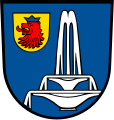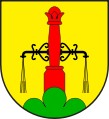Fountain (heraldry)
The fountain can be found in modern heraldry as a common figure in many coats of arms of cities and communities. Its representation is a stylized form. There are one, two or three bowls on top of each other in decreasing size, like an étagère in the coat of arms . The water fountain bubbles in silver or blue if the field color allows it. It gushes from the upper shell into a lower one, running over the edge or taking the same path to the left and right through the side gargoyles.
In the case of fountains with a bowl, it is possible to let the fountain rise in the middle and then return it to the bowl in two falling jets. The variant with two fountains rising from the side, which meet in the middle, is also possible. Columns as wells from which water flows out are also known. The old form of the draw well is often depicted in coats of arms. There are different reasons for choosing to have a fountain in the coat of arms. Often healing and brine springs in the municipality are the reason for the suitability for a coat of arms. The places are occasionally designated as spa and medicinal baths . Since the fountains were not used in classical heraldry, it must be concluded that there was commercial advertising in modern times. Sagas, legends and other traditions about healing successes and miracles often form the basis for choosing a well.
Often only the fountain in the settlement center (market square or church square) with its history or the unique, special structural design is a reason to depict it in the coat of arms. If there is a lot of space in the coat of arms, a detailed representation is possible. The description becomes complicated, however, because it must then be possible to create a clear coat of arms.
If cities and municipalities are at sources or the courses of rivers or if a lighthouse is shown, it is represented by a wave cut in the base of the shield . The proximity of the terms Brunnen and Born has also found expression in heraldry. A rock with water falling from a crack or from a mountain of three is often to be interpreted as a source. (See district of Calw ). It is also possible to interpret a significant waterfall in the municipality. The newer heraldry has even made shaft towers for oil and gas suitable for coats of arms. Here, however, more business acumen and advertising must be seen than heraldic significance.
speaking: Rothenbrunnen
talking without a well : Schwellbrunn
List fountain in the coat of arms
- Alsenborn ,
- Bad Boll , Bad Ditzenbach , Bad Ditzenbach (old), Bad Füssing , Bad Liebenstein , Bad Salzuflen , Bad Schönborn , Bad Suderode , Bad Überkingen , Bad Wildbad , Bad Zwischenahn , Birresborn , Bornholt , Brunn , Brunnadern , Bruntál , Buchbrunn ,
- Eitelborn , Eppenbrunn ,
- Born (Westheide) , Grasbrunn ,
- Hausbrunn , Hollabrunn , Holzbronn ,
- Karlsruher-Südstadt, Karlsruher-Weststadt, Käshofen , Königsbrunn , Külsheim ,
- Bad Kissingen district , Lonsingen ,
- Marienborn , Maulbronn , Moosbrunn , Mössingen ,
- Neubronn , Neudorf-Bornstein , Niefern-Öschelbronn , Nomborn ,
- Quickborn ,
- Rehborn , Reicholzheim , Rot am See , Rothenbrunnen ,
- Seebronn , Steinbach (Taunus) , Stepfershausen ,
- Tiefenbronn ,
- Vierherrenborn ,
- Waldbüttelbrunn , Weibersbrunn , Weitersborn , Wiesenbronn , Windhagen
Web links
- Well in the Heraldry Wiki












